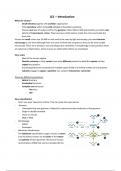Samenvatting
Virology Lecture Summary
- Instelling
- Universiteit Utrecht (UU)
This is a summary I made while following the (electives) Virology course. The key concepts of virology including some key terms are explained in this document. Other life sciences master's program can also take this course as an elective. Alongside the lectures, the tutorials are also a major part ...
[Meer zien]




